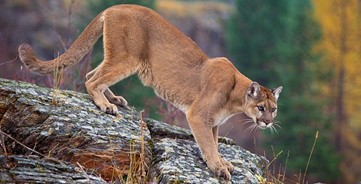Bobcat (Lynx rufus)

Bobcats are common in the Bear Creek watershed, but they are secretive, usually nocturnal, and rarely seen. If they are seen, they can easily be mistaken for big house cats. Identify them by their size, their spots, tufted ears, and their namesake “bobbed” or short tails which are black on top and white below. Their preferred food is rabbit, but they will eat any small mammal or bird and will scavenge carcasses of larger animals.
Also worth knowing: Lynx (Lynx canadenis) are similar to Bobcats but were extirpated (made extinct locally) from Colorado in the 1970s. Reintroduced starting in 1999, they are now found in wilderness areas at high elevation where they are increasing in numbers, but they are not seen in this area.
To learn the differences between Lynx and Bobcats, and about the reintroduction of Lynx to Colorado, go to: Identifying a Lynx
Mountain Lion (Felis concolor)

The Mountain Lion, Colorado’s largest cat, is also called cougar, puma, panther, catamount, or just plain lion. A full-grown adult may measure more than six feet long, have a 3-foot-long tail, and weigh 130 pounds or more. Mountain Lions are reddish to buffy in color with paler undersides. They prey on other animals, especially Mule Deer, which they hunt by ambush. They will drag a carcass to a safe place where they can hide it, protect it, and feast on it over the course of a few days. They will also take other mammals, including the family dog or cat.
Although Mountain Lions are present in the Bear Creek watershed, they are rarely seen. They are dangerous to people and pets and should be avoided! If you see a Mountain Lion, do not run. He is faster than you are, can bound up to 40 feet, and can leap 15 feet up onto a tree branch, rock or roof. Talk quietly, back away slowly, and keep an eye on him without making eye-contact.
To learn more about Mountain Lions go to: